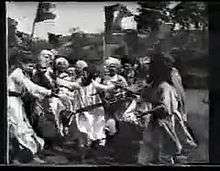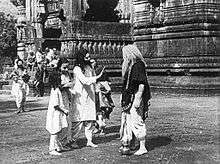Raja Harishchandra
| Raja Harischandra | |
|---|---|
 | |
| Directed by | Dadasaheb Phalke |
| Produced by |
Dadasaheb Phalke for Phalke's Films |
| Written by | Dadasaheb Phalke |
| Story by | Ranchhodbai Udayram |
| Starring |
D. D. Dabke P. G. Sane |
| Cinematography | Trymbak B. Telang |
Release dates |
|
Running time | 40 minutes |
| Country | India |
| Language |
Silent film Marathi intertitles |
Raja Harishchandra is a 1913 Indian mythological silent film, directed and produced by Dadasaheb Phalke, and is the first full-length Indian feature film.[1] The film was based on the legend of Raja Harishchandra, recounted in the Ramayana and Mahabharata. The silent film had intertitles in Marathi, English and Hindi and its cast and staff were primarily Marathi people.
The film marked a historic benchmark in the film industry in India. Only one print of the film was made and shown at the Coronation Cinematograph. It was a commercial success and paved the way for more such films.[2]
Plot
The film opens with a scene of a tableaux patterned on the painting by Raja Ravi Varma, of Raja Harishchandra and his wife with their son. The film revolves around the noble and righteous king, Harishchandra, who first sacrifices his kingdom, followed by his wife and eventually his children to honour his promise to the sage Vishwamitra. Though, in the end, pleased by his high morals, the Gods restore his former glory, and further bestow him with divine blessings.
Cast
Dattatraya Damodar Dabke, a Marathi stage actor played the lead role of Raja Harischandra. The female lead role of Taramati, Harischandra's wife was played by Anna Salunke, a male actor. Phalke's son Bhalachandra D. Phalke was the child artist who donned the role of Rohtash, son of Harischandra.[2] Sage Vishwamitra's role was played by G.V. Sane. The story was an adaptation from the Hindu mythology and was scripted by Ranchhodbai Udayram and Dada Saheb Phalke. Other artists in the film were:
- Dattatreya Kshirsagar
- Dattatreya Telang
- Ganpat G. Shinde
- Vishnu Hari Aundhkar
- Nath T. Telang
Production
Dhundiraj Govind Phalke, popularly addressed in reverence, as Dada Saheb Phalke, who eventually came to don the title "father of Indian Cinema",[3] was the director, script writer and producer of the film. He started a studio in Dadar Main Road. He wrote the screen play, and created the sets for the film and started shooting the film himself. The film was Dada’s first feature film venture of full film length of 3700 ft (in four reels) about 50 minutes of running time, and it took seven months 21 days to complete the film.[4][5] The film was screened at the Coronation Cinema in 1913 before invited audience of the representatives of the press and guests. The film received wide acclaim and was a commercial success. Phalke followed it up by making films such as Satyavan Savitri, Satyawadi Raja Harish Chandra(1917), Lanka Dahan(1917), Sri Krisna Janma(1918) and Kaliya Mardan(1919).[3]
Phalke was greatly influenced by the style of painter Raja Ravi Verma in the making of his films. Just as Verma brought Hindu mythology on canvas, Phalke brought it in motion pictures.[6] He would make many films based on mythological stories from Ramayana, Mahabharata and others.
The film had an all-male cast as no woman was available for playing female leads.[7] Phalke struggled to get woman, including nautch girls, to agree to act in film. He hence had to cast a delicate-looking man to play the role of Queen Taramati, Harishchandra's wife. Phalke discovered Salunke, who used to work in a restaurant as a cook, for this role. Salunke would later play the role of both Rama and Sita in Phalke's 1917 film Lanka Dahan and become the most popular actor and actress of his time.[8] Dadasaheb's wife cooked food alone, without any help, for the whole cast and crew, which were more than 500 people. She also washed the clothes and costumes, helped in the posters and production of the film, and co-operated with the cast, satisfying them with food and water.[4]
Harishchandrachi Factory is a 2009 film based on the making of Raja Harischandra. The title is based on the fact that, when the film was made, working in films was taboo, so Dada Saheb advised his artists to tell others that they were working in the factory of one 'Harishchandra'.[9]
Classification as first Indian film
Some have argued that Raja Harischandra cannot be called the first Indian film as Dadasaheb Torne's film Shree Pundalik was released on 18 May 1912 in Bombay, one year before Phalke's film. However, Shree Pundalik is a cinematographic recording of play, using a single, fixed camera; it is one of a number of such Indian films that predated Raja Harishchandra. Additionally, the cameraman for Shree Pundalik was a Briton, and the film stock was processed in London.[10][11]
Release
The film premiered on 21 April 1913 at the Olympia Theatre, Grant Road for a selective audience that included famous personalities of Bombay (Mumbai) and editors of many newspapers.[12] It was first shown in public on 3 May 1913[13][14] at Bombay's Coronation Cinema, Girgaon, where crowds thronged the roads outside the hall, as it marked the beginning of the Indian film industry. The film was so successful that Dada Saheb had to make more prints to show the film in rural areas as well. The film was a grand success and soon established Phalke as a producer and paved the way for the Indian film industry.
Extant Prints
The original film was in four reels, and the National Film Archive of India, Pune has only the first and last reels. Some film historians believe that they belong to a 1917 remake of the film, by the same name.[15]
Gallery
 King Harishchandra, in a scene from Raja Harishchandra, 1913.
King Harishchandra, in a scene from Raja Harishchandra, 1913..jpg) A scene from the film Raja Harishchandra, 1913.
A scene from the film Raja Harishchandra, 1913.
See also
- Marathi Cinema
- Alam Ara - The first Indian sound film
- List of incomplete or partially lost films
- List of Hindu mythological films
References
- ↑ Overview New York Times
- 1 2 Ramesh Dawar (1 January 2006). Bollywood Yesterday Today and Tomorrow. Star Publications. pp. 1987–. ISBN 978-1-905863-01-3. Retrieved 5 April 2013.
- 1 2 Kirpal Sigh Annie Mathew. Middle School Social Sciences. Frank Brothers. pp. 8–. ISBN 978-81-8409-103-8. Retrieved 7 April 2013.
- 1 2 The Beginning: The Silent Movie Era, Asia Studies, University of Berkeley.
- ↑ Dawar 2006, p. 9.
- ↑ Tamhane, Abhijit (28 April 2008). "एक मल्याळी चित्रकार 'मराठी' चित्रं रंगवतो..." (in Marathi). Maharashtra Times. Retrieved 8 June 2012.
- ↑ Subhash K. Jha,. "10 pre-release big ones". Rediff.com. Retrieved 8 June 2012.
- ↑ "Dadasaheb Phalke: Father of Indian Cinema". Dadasaheb Phalke Academy. Retrieved 8 June 2012.
- ↑ Plan to showcase making of India's 1st film bignews.big927fm.com
- ↑ Damle, Manjiri (21 April 2012). "Torne's 'Pundlik' came first, but missed honour". The Times Of India.
- ↑ Mishra, Garima (3 May 2012). "Bid to get Pundalik recognition as first Indian feature film". The Indian Express. Retrieved 3 May 2013.
- ↑ Bhingarde, Santosh (21 April 2012). "भारतातील पहिल्या "प्रीमियर'चे आज शताब्दी वर्षात पदार्पण" (in Marathi). Mumbai: Sakal. Retrieved 8 June 2012.
- ↑ Today in History 3 May, NDTV.
- ↑ "Anurag Kashyap shoots in Amitabh Bachchan's home - The Times of India". The Times Of India.
- ↑ Raja Harishchandra National Film Archive of India.
External links
| Wikimedia Commons has media related to Raja Harishchandra. |
.jpg)